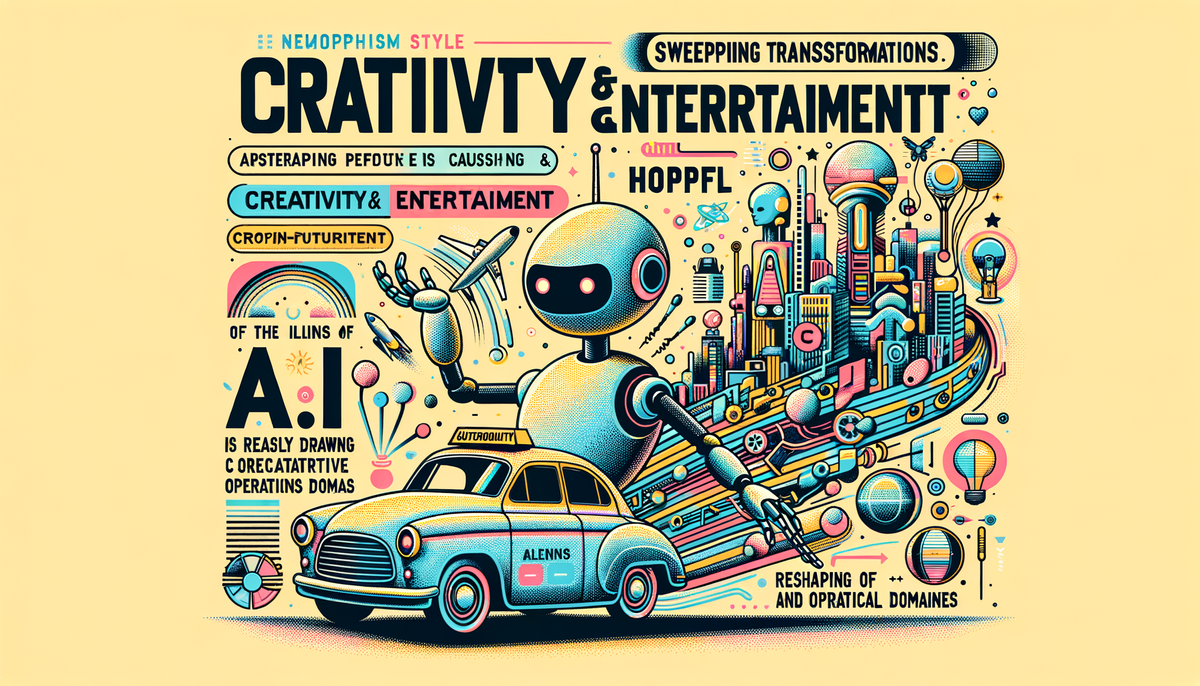AI Advancements and Impacts Across Industries

The breakthrough unveiling of a 100% automotive-grade autonomous robotaxi stands as a vivid testament to the sweeping transformations AI is carving across industries—from redefining urban mobility to reshaping creative and operational domains.
Pioneering Autonomous Mobility
In a stunning display of technological prowess, a leading autonomous mobility company has introduced its seventh-generation Robotaxi lineup at an international auto show. With plans for mass production commencing in mid-2025, this new roster not only highlights a dramatic 70% reduction in material costs compared to previous designs but also integrates a state-of-the-art autonomous driving kit tailored for heightened safety and vehicle stability.
The innovation centers around a split-second computational efficiency, reducing processing needs by an impressive 80%. Moreover, solid-state LiDAR systems have become substantially more cost-effective, slashing expenses by 68%. Such leaps in hardware optimization are matched by advances in software—most notably, the development of a proprietary driving simulation system that creates realistic scenarios to test and refine driver behavior. This repository of simulation data, known in-house as PonyWorld, ensures the decision-making process advances beyond human limitations.
Collaborations with automotive titans are central to this vision. Partnerships with manufacturers like Toyota, BAIC, and GAC underscore the flexible, vehicle-agnostic design of the robotaxi platform. This modularity not only promises a future where autonomous vehicles seamlessly integrate into diverse transportation sectors but also hints at an eventual extension to domains like robotic trucking services.
One cannot help but notice the strategic emphasis on three core pillars: technology readiness, product integration, and operational perfection. As Dr. James Peng, CEO of the company, remarked, this trifecta is fueling an era where Level 4 autonomy could, in practical terms, outperform human drivers on safety standards. Such advances pave the way for a future where our daily commute becomes a paradigm of safety, efficiency, and cost-effectiveness.
Navigating Transparency in AI Advertising
Simultaneously, the broader AI landscape is wrestling with the ethical and practical implications of its innovations. A high-profile case concerning an acclaimed tech giant’s advertised AI features exemplifies this tension. Recent advertising campaigns promoting the next-generation smartphone came under scrutiny when prominent watchdogs found that the promotional claims did not accurately reflect the actual availability of its AI enhancements.
The controversy ignited over a widely broadcast ad, featuring popular celebrity Bella Ramsey, that showcased an upgraded virtual assistant—yet as events unfolded, the promised features were delayed, reaching consumers only the following year. Regulatory bodies soon declared that these discrepancies not only misled the public but also sowed seeds of confusion in a market where consumer trust is essential. With class-action lawsuits burgeoning and consumer sentiment sharply divided, the incident has become a cautionary tale about linking promotional hype directly with technical capability.
This development teaches us that in the fast-paced race for AI supremacy, clarity and transparency are as vital as technological ingenuity. As industry leaders recalibrate their messaging—shifting ad taglines from bold claims to more inclusive promises like "AI for the rest of us"—the ecosystem is reminded that genuine innovation must be paired with trustworthy communication.
Efficiency in AI Interaction: The Courtesy Debate
Alongside these tech milestones, discussions surrounding everyday interactions with AI continue to spark lively debates. Recent voices within the tech community have pondered whether habitual politeness—saying “please” and “thank you” when communicating with systems like ChatGPT—actually makes a difference. While a significant number of users maintain these etiquettes as ingrained habits, others argue that such niceties merely add extra processing load without enhancing the quality of the resulting interactions.
Notably, a prominent AI leader has highlighted that these courteous phrases could be costing millions in processing power and even contributing to environmental inefficiencies. One tech commentator humorously noted that in the race against time and energy constraints, straightforward queries are often the most effective. A 2024 study revealed that nearly 67% of American users continue their polite routines, questioning if these social norms will persist when future machines evolve closer to human-like consciousness.
In an era where time is of the essence and computational resources are prized, this debate reflects broader concerns about efficiency versus tradition in our digital dialogues. Whether one chooses formality or brevity, this discussion underlines the broader challenge of aligning human behaviors with the practical demands of advanced technology.
AI’s Creative Frontier in Cinema
The transformative reach of AI is not confined to utilitarian applications; it is also making a bold entrance into the artistic realms of cinema. The Academy has recently altered its long-standing eligibility criteria to welcome films crafted with significant AI involvement. This historic decision marks a pivotal moment where automating certain creative processes coexists with traditional human storytelling.
Emerging alongside this new era are films that fuse AI-generated visual effects with voice cloning technologies. For instance, acclaimed cinematic works have employed AI to refine actor performances—fine-tuning accents or even synthesizing entire vocal tracks. Critics, however, voice concerns over whether AI can truly capture the nuanced emotional depth that defines award-winning art. Yet, the new guidelines maintain that the integration of technology will neither unduly favor nor disadvantage submissions.
This balance attempts to honor the age-old spirit of creativity while embracing innovative techniques. Whether one views AI as a mere tool or a collaborative creative partner, its impact on the film industry is undeniable, paving the way for an enriched tapestry of storytelling possibilities.
Innovative Infrastructure: Docker Strategies and Lightweight AI Models
Beyond consumer-facing products, the underlying infrastructure supporting AI is evolving at a rapid clip. A notable illustration comes from a major containerization platform that has launched its updated toolkit, designed to harness the emerging Model Context Protocol (MCP). This suite of tools not only simplifies the life cycle of AI application development but also fortifies security principles across the board.
Through strategic collaborations with industry leaders, the platform enables developers to seamlessly discover and deploy various MCP tools via a popular software hub, ensuring that even startups and independent developers can contribute to this burgeoning ecosystem.
In parallel, an innovative approach from a renowned global tech company has demonstrated that advanced AI models need not rely solely on expensive, power-hungry GPUs. Leveraging a clever 1-bit architecture, researchers have developed an AI model that runs efficiently on standard CPUs. Known as BitNet, this model shows remarkable efficiency by reducing memory usage from typical demands of 2–5 GB down to less than 0.4 GB.
The transformative potential of such innovations is enormous. Imagine deploying capable AI, from natural language processing to real-time decision-making, directly on everyday devices like laptops and smartphones. In doing so, not only does this cut energy consumption significantly, but it also democratizes access to AI, pushing its benefits closer to the end user.
“There are no shortcuts when it comes to AI. It requires collaboration and time to make it work in ways that benefit humanity.” – Elon Musk, Founder of Tesla and SpaceX, 2017
This dual approach—enhancing developer infrastructure while optimizing operational efficiency—ushers in a future where AI solutions are more accessible, sustainable, and secure.
Impacts on Workforce and Cybersecurity
While technology races ahead, the impact on workforce dynamics cannot be overlooked. A recent study in a pioneering city revealed that one-third of government jobs may be at risk due to the rapid acceleration of AI deployment. In regions known for their administrative stability and public service, these changes urge both industries and governments to invest in strategic re-skilling and change management.
This trend reflects a broader global phenomenon where automation is pushing the boundaries of traditional workplaces. Meanwhile, in the private sector, AI continues to create cutting-edge solutions in cybersecurity. An emerging startup has captured significant investor interest by launching an AI-driven virtual Chief Information Security Officer tailored for small and medium businesses. By offering a cost-effective alternative to human cybersecurity experts, this virtual CISO helps companies navigate a challenging digital threat landscape.
The virtual CISO platform’s capabilities span comprehensive vulnerability assessments, policy development, and real-time remediation tracking. Its innovative approach not only addresses the evident shortage of on-demand cybersecurity expertise but also provides a scalable solution designed to adapt across different business contexts.
As industries grapple with workforce transitions alongside surging cybersecurity demands, proactive steps—such as investing in re-skilling programs and adopting AI-powered security measures—will prove vital for maintaining competitive advantage and resilience in an ever-changing market.
Investor Landscape and Regulatory Oversight
On another front, the AI market has long been described as the Wild West for investors. The rapid pace of innovation has led to an environment where unbridled enthusiasm often outpaces regulatory structures. However, recent commentary suggests that a new era of oversight is emerging—a “sheriff” is coming to town to ensure that investment in AI is both sustainable and transparent.
This development is significant not merely because it promises to reduce fiscal risk but also because it helps align the lofty promises of AI with tangible, measurable outcomes. Investors are increasingly looking toward companies that deliver clear, achievable technological milestones rather than lofty promises. With regulatory bodies beginning to scrutinize the veracity of publicly traded AI claims, the market landscape may finally stabilize into one that is less volatile and more predictable.
Such changes resonate with broader calls for accountability in technology sectors. As businesses recalibrate their approaches to marketing, product rollout, and even investor communications, one can appreciate the wisdom in embracing a measured, deliberate approach to innovation.
Convergence of Innovation and Future Prospects
Reflecting on these diverse developments—from groundbreaking autonomous mobility and navigation of marketing pitfalls, to debates about digital politeness and the reimagining of the cinematic experience—a common thread emerges. AI is not simply a tool or a technological phenomenon; it is a transformative force that is intricately weaving itself into the very fabric of modern society. Whether recalibrating the logistical frameworks of urban mobility, redefining creative expression on the silver screen, or enhancing even the subtleties of digital communication, AI’s influence is pervasive.
The journey forward involves both embracing and mitigating the multifaceted impacts of these advancements. For those curious to dig deeper into how various industries are being reshaped by AI, I encourage a visit to our recent insights on AI's impact across industries and discussions on upcoming AI predictions. By cross-examining industry-specific innovations, one can appreciate the levels of complexity and opportunity that AI presents to society.
In the ever-evolving dialogue between technology and humanity, it remains clear that AI is as much a story about our future potential as it is about the clever engineering behind each new development. This convergence of technology, art, and commerce is a vivid demonstration of what happens when breakthrough research meets practical application—a ceaseless cycle of challenge and progress.
Embracing these changes is not merely about staying on the cutting edge; it is about reshaping our values, workspaces, and economies in ways that enhance both efficiency and inclusivity. As one navigates the exciting landscape of AI, the future promises to be as bold as it is unpredictable—a narrative where every advancement carries with it the spark of transformative potential.
Further Readings and Reflections
For those eager to explore additional perspectives and in-depth analyses on the diverse impacts of artificial intelligence, consider diving into our related articles on industry impacts, cultural impressions, and emerging innovation challenges:
- Exploring the Impact of AI Across Industries
- AI Innovations and Challenges on the Horizon
- Cultural Impressions and Ethical Dimensions of AI
- Predictions for AI Innovations in the Next Decade
With expert opinions, data-driven insights, and a dash of creative narrative, the future of AI is a story still being written. In our journey through these developments, the words of Satya Nadella ring especially true: “We are entering a new phase of artificial intelligence where machines can think for themselves.”
A Final Thought
As we stand at the cusp of an AI-powered era, every breakthrough and every debate—from autonomous vehicles to AI-enhanced art—serves as a reminder of the endless possibilities that lie ahead. The subtle interplay between engineered precision and creative ingenuity confirms that while the path ahead may be complex, it is one ripe with promise and innovation.



